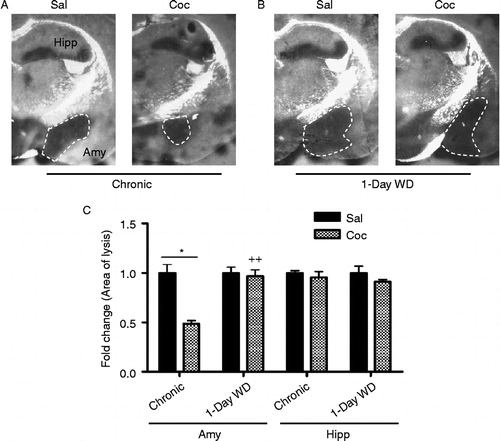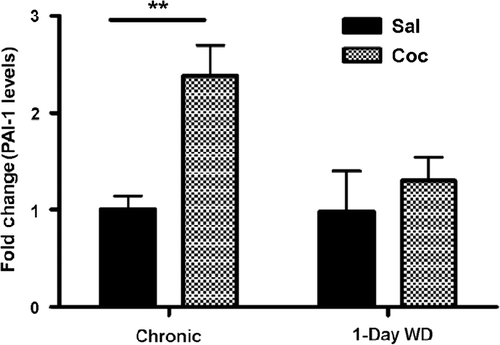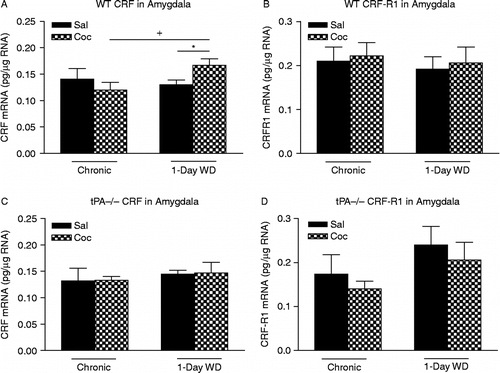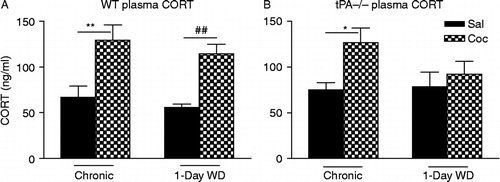Figures & data
Figure 1. Extracellular tPA activity in the Amy and Hipp of WT mice was measured by in situ zymography 30 min after 14 days of chronic “binge” pattern cocaine administration (Chronic Coc) and 1 day after 14 days of Chronic Coc as 1-day WD (A,B). tPA activity (indicated by dark lytic zones) in the CeA and MeA (A) was quantified by measuring the area of lysis outlined by dashed white line (C). Data in graph C are presented as mean ± SEM. tPA activity was significantly decreased in the CeA and MeA of WT mice 30 min after 14 days of chronic “binge” cocaine (Chronic Coc), compared to those of saline-injected mice (*p < 0.05). Significant differences are also found between Chronic Coc and 1-day WD groups (++p < 0.01) (n = 3–4/group). In the hippocampus, tPA activity remained unchanged at both time points examined (C).

Figure 2. PAI-1 levels in the Amy of WT mice were examined by ELISA 30 min after 14 days of chronic “binge” pattern cocaine administration (Chronic Coc) and 1-day after 14 days of Chronic Coc as 1-day WD. Data in the graph are presented as mean ± SEM. PAI-1 levels were significantly enhanced in cocaine-treated animals 30 min after 14 days of chronic “binge” cocaine (Chronic Coc), compared to those of their saline- injected counterparts (**p < 0.01) (n = 3–4/group).

Figure 3. mRNA levels of corticotropin-releasing factor (CRF) (A,C) and CRF1 receptor (B,D) in the Amy of WT and tPA-deficient (tPA − / − ) mice were examined 30 min after 14 days of chronic “binge” pattern cocaine administration (Chronic Coc) and 1 day after 14 days of Chronic Coc as 1-day WD. Data in the graph are presented as mean ± SEM. (A) In the Amy of WT mice, significant differences are indicated: +p < 0.05 between 1-day WD vs. chronic cocaine (Chronic Coc) groups; *p = 0.06 between 1-day WD from cocaine (1-day WD Coc) and 1-day WD from saline (1-day WD Sal) groups. (B) No significant differences in CRF1 receptor mRNA levels in WT mice were observed at either of the time points examined. (C,D) No significant differences in mRNA levels of either CRF or CRF1 receptor in tPA − / − mice were observed at either of the time points examined (n = 4–6/group).

Figure 4. Plasma CORT levels in WT (A) and tPA-deficient (tPA − / − ) mice (B) were examined 30 min after 14 days of chronic “binge” pattern cocaine administration (Chronic Coc) and 1 day after 14 days of Chronic Coc (1-day WD). Data in the graph are presented as mean ± SEM. (A) In WT mice, significant differences are indicated: **p < 0.01 between chronic cocaine (Chronic Coc) vs. saline (Chronic Sal); ##p < 0.01 between 1-day acute WD (1-day WD) from cocaine vs. saline control (n = 5–8/group). (B) In tPA − / − mice, significant differences are indicated: *p < 0.05 between chronic cocaine (Chronic Coc) vs. saline (Chronic Sal).

Table I. mRNA levels of CRF, CRF type 1 receptor (CRF-R1) or POMC (pg/μg RNA) in the Hypo or AP in the wildtype (WT) (A) and tPA-deficient (tPA − / − ) (B) mice were examined 30 min after 14 days of chronic “binge” pattern cocaine administration (Chronic Coc) or saline (Chronic Sal) and 1 day after 14 days of Chronic Coc or Chronic Sal as 1-day WD Coc or 1-day WD Sal.